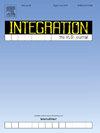Comparison of integer-order chaotic attractors as randomness source in collision-free robotic exploration methods
IF 2.2
3区 工程技术
Q3 COMPUTER SCIENCE, HARDWARE & ARCHITECTURE
引用次数: 0
Abstract
This article presents a comparison on the use of integer-order chaotic waveforms in collision-free robotic navigation methods. Each state-variable associated with the Lorenz’s, Rossler’s, Chen’s, Liu’s, Chua’s and Saturated Nonlinear Function Series system is used to compute the coverage, which represents the effectiveness over the amount of the total area covered by the mobile robot. As a result, it can be deduced which dynamic system and state-variable are most suitable to be used as randomness source within the robotic exploration methods. All positions of the mobile robot are generated by the state-variable of the chaotic dynamic system and the inverse Jacobian of the mobile robot is used as control law. The position error at each point of the chaotic path is iteratively reduced and the angular velocities for each motion are computed. Numerical simulations were performed in the Matlab environment and illustrate the usefulness of the best collisionless chaotic path generator with the largest coverage, which can be applied to various areas, such as household, agriculture, education, manufacturing, patrolling, medical care, military and so on.
无碰撞机器人探索方法中作为随机源的整数阶混沌吸引子比较
本文比较了整数阶混沌波形在无碰撞机器人导航中的应用。使用与Lorenz’s, Rossler’s, Chen’s, Liu’s, Chua’s和饱和非线性函数级数系统相关的每个状态变量来计算覆盖范围,它表示移动机器人覆盖总面积的有效性。从而推导出在机器人勘探方法中,哪一种动态系统和状态变量最适合作为随机源。移动机器人的所有位置由混沌动力系统的状态变量生成,并以移动机器人的逆雅可比矩阵作为控制律。迭代地减小混沌路径上各点的位置误差,计算各运动的角速度。在Matlab环境下进行了数值仿真,说明了该无碰撞混沌路径生成器具有最大覆盖范围的实用性,可应用于家庭、农业、教育、制造业、巡逻、医疗、军事等各个领域。
本文章由计算机程序翻译,如有差异,请以英文原文为准。
求助全文
约1分钟内获得全文
求助全文
来源期刊

Integration-The Vlsi Journal
工程技术-工程:电子与电气
CiteScore
3.80
自引率
5.30%
发文量
107
审稿时长
6 months
期刊介绍:
Integration''s aim is to cover every aspect of the VLSI area, with an emphasis on cross-fertilization between various fields of science, and the design, verification, test and applications of integrated circuits and systems, as well as closely related topics in process and device technologies. Individual issues will feature peer-reviewed tutorials and articles as well as reviews of recent publications. The intended coverage of the journal can be assessed by examining the following (non-exclusive) list of topics:
Specification methods and languages; Analog/Digital Integrated Circuits and Systems; VLSI architectures; Algorithms, methods and tools for modeling, simulation, synthesis and verification of integrated circuits and systems of any complexity; Embedded systems; High-level synthesis for VLSI systems; Logic synthesis and finite automata; Testing, design-for-test and test generation algorithms; Physical design; Formal verification; Algorithms implemented in VLSI systems; Systems engineering; Heterogeneous systems.
 求助内容:
求助内容: 应助结果提醒方式:
应助结果提醒方式:


